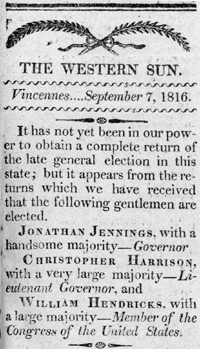The Final Steps to Statehood
Following adjournment of the convention, there was action on two fronts--in Indiana Territory and in Washington. Indiana's Constitution was implemented upon passage, before Indiana was formally admitted to the union on December 11, 1816. The people did not vote on the Constitution.

The Vincennes Western Sun issue of September 7, 1816 provided this interesting announcement of the results of the August 5 election. The August 31 issue indicates that the paper has no returns yet from Dearborn, Franklin, Gibson, Perry, Posey, and Warrick counties.
Events in Indiana
The transition process was stated in Article 12 of the Constitution. Most sections provide for the legal transition from territory to state so that all "shall continue as if no change had taken place in this Government."
Section 8 of Article 12 required that the convention president notify the sheriffs of all counties to call for an election on August 5. Jonathan Jennings' writ of election to the Knox County sheriff and the sheriff's resulting order were printed in the Vincennes Western Sun, July 6, 1816. There were only five weeks between the end of the convention and the election. Jennings beat Thomas Posey in the gubernatorial race 5,211-3,934.
Section 9 of Article 12 established county representation in the General Assembly until the next census--twenty-nine representatives and ten senators. The first General Assembly under the Constitution met November 4, 1816.
Governor Jennings and Lieutenant Governor Christopher Harrison were inaugurated on November 7. On November 8, the General Assembly elected its two members for the U.S. Senate--James Noble and Waller Taylor.
In Washington
Acceptance by the convention of the provisions of the Enabling Act on June 22 helped fulfill the requirements of the Enabling Act. On July 6, Jennings transmitted the acceptance to Washington, as ordered by the convention June 27, to begin the final steps.
The seating of the Indiana congressional delegation was also an important step. Indiana's elected representative, William Hendricks, was sworn into office and seated in the U.S. house on December 2, 1816. Indiana's two senators, elected by the General Assembly, were sworn in and seated on December 12.
The resolution admitting Indiana "into the Union on an equal footing with the original States, in all respects whatever" was signed by President James Madison on December 11, 1816, which has been celebrated as Indiana's birthday ever since.
The final step of admission, however, was not accomplished until March 3, 1817, when "AN ACT to provide for the due execution of the laws of the United States within the State of Indiana" was approved.
Sources: Kettleborough, 1:65, 120-33; Barnhart and Riker, 460-62.
